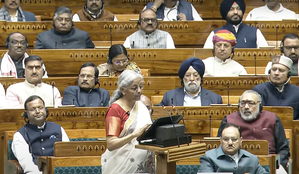THEBUSINESSBYTES BUREAU
NEW DELHI, FEBRUARY 1, 2025
The Union Budget 2025-26, presented by Finance Minister Nirmala Sitharaman under the Modi 3.0 government on Saturday, charts a path for accelerated economic growth while maintaining fiscal discipline. With a strong focus on inclusive development, the budget seeks to boost private sector investments, enhance the spending power of India’s growing middle class, and drive aggregate demand.
A key highlight of the budget is its commitment to fiscal consolidation. The fiscal deficit is set to decline from 4.8% of GDP in 2024-25 to 4.4% in 2025-26, even as capital expenditure remains robust at ₹11.21 lakh crore. This continued emphasis on infrastructure spending is expected to create jobs and spur economic growth. Emphasizing this point at a post-budget press conference, Sitharaman stated, “There is no reduction in public capital expenditure. The government remains committed to the multiplier effect of capital investment while ensuring fiscal prudence.”
 The budget introduces transformative reforms across multiple sectors, aiming to enhance India’s global competitiveness. It prioritizes the welfare of the poor, youth, farmers (Annadata), and women (Nari), while also targeting structural improvements in taxation, power, urban development, mining, and financial regulations. Agriculture remains a focal point, with a new Agricultural District Programme set to transform 100 low-productivity districts in partnership with states. This initiative is expected to benefit 1.7 crore farmers. The government has also launched a Mission for Cotton Productivity, a five-year initiative aimed at improving cotton yield and promoting extra-long staple varieties. This aligns with India’s 5F vision for the textile sector and aims to enhance farmer incomes while ensuring a steady supply of quality cotton for the industry.
The budget introduces transformative reforms across multiple sectors, aiming to enhance India’s global competitiveness. It prioritizes the welfare of the poor, youth, farmers (Annadata), and women (Nari), while also targeting structural improvements in taxation, power, urban development, mining, and financial regulations. Agriculture remains a focal point, with a new Agricultural District Programme set to transform 100 low-productivity districts in partnership with states. This initiative is expected to benefit 1.7 crore farmers. The government has also launched a Mission for Cotton Productivity, a five-year initiative aimed at improving cotton yield and promoting extra-long staple varieties. This aligns with India’s 5F vision for the textile sector and aims to enhance farmer incomes while ensuring a steady supply of quality cotton for the industry.
Further strengthening the agriculture sector, the Modified Interest Subvention Scheme will see an increase in the loan limit for Kisan Credit Card (KCC) holders from ₹3 lakh to ₹5 lakh, benefiting 7.7 crore farmers, fishermen, and dairy farmers. The fisheries sector has received its highest-ever allocation of ₹2,703.67 crore, strengthening India’s blue economy. The budget’s focus on aquaculture and seafood exports aims to boost financial inclusion and ease trade restrictions through reduced customs duties.
The budget provides a major thrust to employment-driven growth with the launch of the National Manufacturing Mission. Covering small, medium, and large industries, the mission focuses on improving the ease and cost of doing business, developing a future-ready workforce, strengthening the MSME sector, advancing technology adoption, and ensuring quality manufacturing. It will also support clean tech manufacturing, focusing on domestic production of solar PV cells, EV batteries, wind turbines, high-voltage transmission equipment, and grid-scale batteries.
To boost job creation in labour-intensive sectors, the government has announced a new Footwear and Leather Industry Scheme. This initiative will support design capacity, component manufacturing, and machinery for both non-leather and leather products, generating an estimated 22 lakh jobs with a projected turnover of ₹4 lakh crore and exports exceeding ₹1.1 lakh crore. Similarly, the toy industry will receive a strategic push with a new scheme under the National Action Plan for Toys. This initiative aims to position India as a global toy manufacturing hub by fostering clusters, skill development, and innovation.
Sitharaman emphasized that exports will be a “fourth engine of growth,” with the newly introduced Export Promotion Mission helping MSMEs expand into global markets. Driven jointly by the Ministries of Commerce, MSME, and Finance, this mission is expected to further India’s standing in international trade.
 The Business Bytes
The Business Bytes